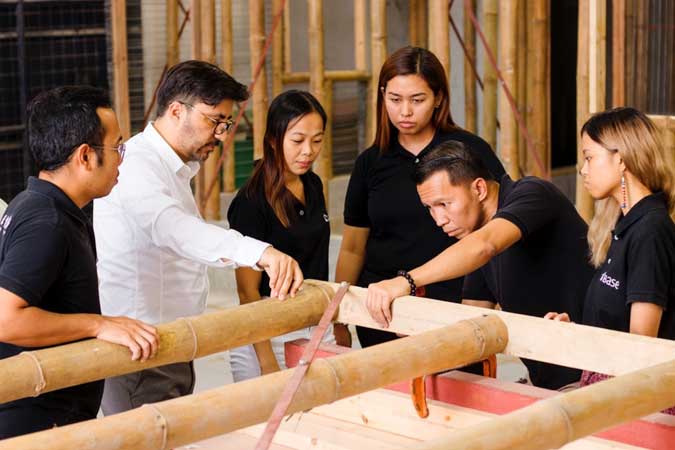Bamboo seen as ideal building material for sustainable homes
By Cathy Rose A. Garcia

BASE BAHAY Foundation, Inc. in January launched the Base Innovation Center in Makati City. — COMPANY HANDOUT
BAMBOO isn’t often used to build homes in the Philippines, as many consider this as “a poor man’s material.”
Base Bahay Foundation, Inc. is hoping to change this perception, as it pushes for the use of bamboo as an alternative building technology for socialized housing in the country.
“What we want to change with this misconception is that bamboo, just like any other material, can be used just as well for strong structures when used properly and with the sufficient technology,” Maricen Jalandoni, president of Base Bahay Foundation, Inc. said in an e-mail interview with BusinessWorld.
She said a German engineer named Corina Salzer wrote her master’s thesis in 2012 on the use of bamboo for affordable homes in Asia and Pacific countries that face natural disasters every year.
“The Philippines has both the bamboo — a resource that grows incredibly fast and is freely available — and the complexities of a developing country with challenges on housing and natural disasters. This makes bamboo an ideal building material for sustainable housing in the country; especially for the many people living in informal settlements, vulnerable to disasters,” she said.
Base Bahay, together with non-governmental organizations and Hilti Foundation, pioneered the research and development of new bamboo building techniques.
Luis Lopez, head of technology at Base Bahay Foundation, Inc. said they developed the cement bamboo frame technology (CBFT), a prefabricated frame system that uses load-bearing bamboo with metal connections and mortar cement plaster.
“The raw materials and connections are tested to ensure a durable and reliable load transfer that will allow for a structural design that will match the intended resistance of the system. This system is also tested for resistance to earthquakes, typhoons, fires, and insect infestation,” Mr. Lopez said.
To address concerns over “bokbok” termite infestation in bamboo homes, Base has also developed a treatment process that eliminates bamboo starch and introduced solutions to protect it from termites.
In January, Base Bahay Foundation, Inc. launched the Base Innovation Center (BIC), considered the “first research and testing facility for sustainable and disaster-resilient construction technologies” in the Philippines.
“BIC is a venue for research and testing programs, as well as continuing professional education and training. We had built this with the goal of advancing bamboo-based technology and other alternative building technologies in mind — towards creation of a better sustainable future,” Dr. Pablo Jorillo, general manager of Base Bahay Foundation, Inc. said.
The center has a universal testing machine, a bamboo wall panel reaction frame, fabrication tables, and a model house, where new materials and building techniques are tested.
MORE COST-EFFICIENT
Base is hoping to widen the acceptance of cement-bamboo frame houses in the country.
Mr. Lopez said cement-bamboo frame houses are “more cost-efficient by 15 to 20%, compared to a conventional house of the same quality.”
“For our projects, we make sure to build houses that are no less than 25 square meters to ensure a comfortable and decent space for the families to live in… With bamboo and cement plaster as its main components, the CBFT-produced homes and structures have also been thoroughly tested and proven to be disaster-resilient, insect-resilient. Apart from being more affordable, it is also able to provide a more comfortable indoor temperature than conventional cement houses,” he said.
A cement-bamboo frame house also has 74% less environmental impact compared to conventional concrete house, Mr. Lopez noted.
“In absolute terms, this relates to a reduction of 9.3 tons of carbon monoxide CO2 equivalents over a service life of 25 years,” he said.
A cement-bamboo frame house typically costs around P8,500-P9,500 per sq.m. with an average of P225,000 for a 25 sq.m. house, Mr. Jorillo said.
“The total cost will ultimately also depend on the location and wind zone of the area. The house includes the space for a common area, a kitchen, a bathroom, and a bedroom which can further be divided into two rooms,” he said.
MORE HOMES
Base has already helped build over 800 homes, when the Hilti Foundation teamed up with the United Nations Economic and Social Commission for Asia and the Pacific to build homes using sustainable materials in Estancia, Iloilo after super typhoon Yolanda (Haiyan) devastated the area.
“Since then, Base has helped build over 800 homes while providing livelihood to farmers and treatment workers within the value chain; from bamboo harvesting, treatment, to house construction — Base’s supply partners harvest, treat, and conduct quality-controls of more than 100,000 full culm bamboos annually,” Ms. Jalandoni said.
She said the foundation is aiming to build 10,000 cement-bamboo frame houses in Negros Occidental, with partners, Habitat for Humanity and HILTI Foundation in line with the Negros Occidental Impact Coalition.
“By using bamboo, Base also supports the livelihood of bamboo farmers and workers in the supply and treatment process, creating a green value chain from bamboo harvesting, treatment, and finally construction of the houses. In this way, we are not only helping the beneficiaries of our socialized homes, but also those who contribute to the success of our construction projects,” Mr. Lopez said.
Source: Business World
